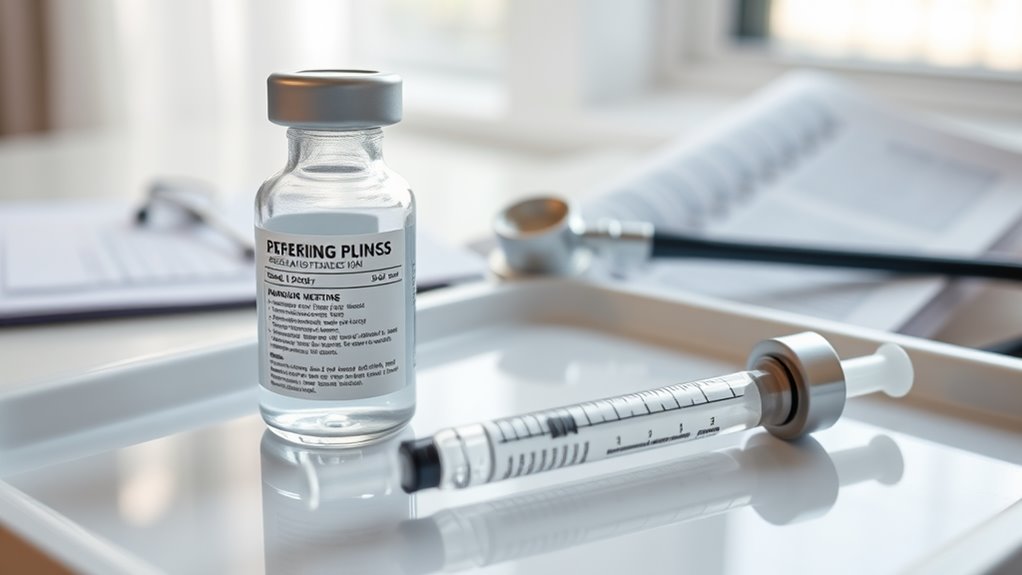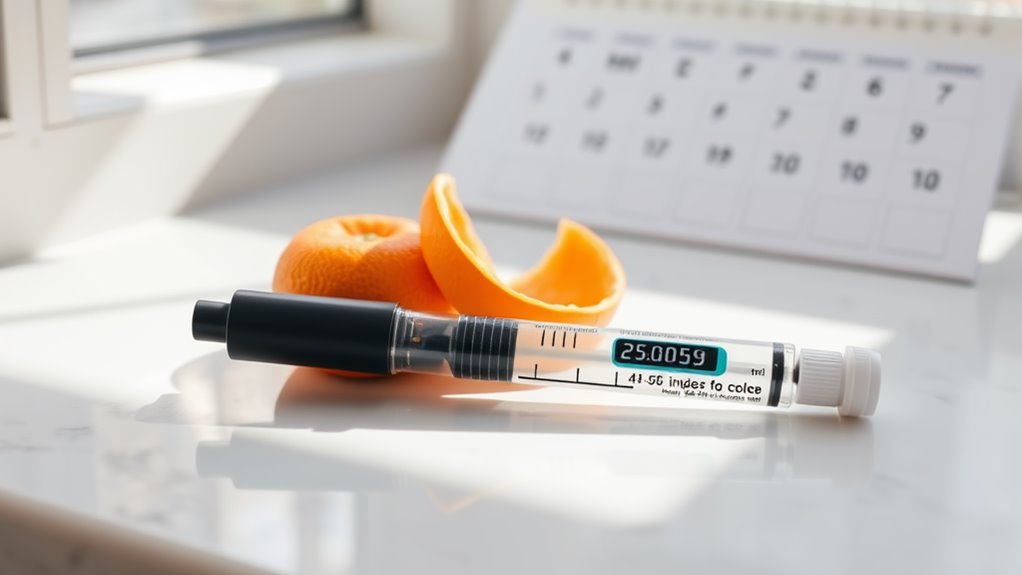Inject yourself weekly with Mounjaro to control diabetes through its groundbreaking dual-action mechanism, but there's more you need to know...

You'll find Mounjaro (tirzepatide) is a once-weekly injectable medication that treats type 2 diabetes through a unique dual-action mechanism. It activates both GLP-1 and GIP receptors, which enhances insulin production while reducing glucagon levels in your body. This FDA-approved treatment can lower your HbA1c by up to 2.6 percentage points over 40 weeks and supports significant weight loss. Understanding its complete benefits and proper usage will help maximize your treatment success.
Mounjaro (tirzepatide) represents a significant advancement in type 2 diabetes treatment as a once-weekly injectable medication that targets both GLP-1 and GIP receptors. This FDA-approved prescription medicine works by mimicking natural hormones involved in glucose regulation and appetite control, setting it apart from traditional diabetes medications through its dual-action mechanism.
When you're prescribed Mounjaro, you'll need to incorporate it into a thorough treatment plan that includes diet and exercise. The medication enhances insulin secretion, improves insulin sensitivity, and decreases food intake while reducing glucagon levels and slowing gastric emptying. You should note that Mounjaro isn't appropriate for type 1 diabetes management or if you've had pancreatitis. Since its approval in May 2022, it's available only as a brand-name medication, with no generic alternatives currently on the market. While weight loss is a noted benefit, it's not an FDA-approved indication for the drug. Treatment typically begins with a 2.5 mg weekly dose, which can be gradually increased based on your response and tolerance.
While many diabetes medications target a single hormone pathway, the groundbreaking dual-action mechanism of tirzepatide represents a significant advancement in metabolic disease treatment. Mounjaro simultaneously activates both GLP-1 and GIP receptors, triggering a cascade of metabolic responses that regulate blood sugar and appetite control.
When you take Mounjaro, it stimulates insulin secretion while reducing glucagon production through its GLP-1 action. The GIP component enhances this effect by promoting additional insulin synthesis in a glucose-dependent manner. This dual-receptor activation also slows gastric emptying and increases feelings of satiety, leading to reduced caloric intake. The medication's combined effect on both hormone pathways results in improved insulin sensitivity and enhanced metabolic rate. Patients must inject once weekly to maintain consistent therapeutic levels.
Clinical trials have demonstrated that this dual-agonist approach produces superior weight loss outcomes compared to single-agonist medications, with efficacy increasing at higher doses.
Healthcare providers turn to Mounjaro for two primary therapeutic applications: managing type 2 diabetes in adults with inadequate glycemic control and supporting weight management in patients with obesity or weight-related conditions.
Clinical trials demonstrate Mounjaro's exceptional efficacy, lowering HbA1c by up to 2.6 percentage points over 40 weeks compared to placebo. You'll receive Mounjaro through weekly subcutaneous injections, starting at 2.5 mg and potentially increasing to a maximum of 15 mg based on your response and tolerance. The injection can be administered in the abdomen, thigh, or arm.
If you're prescribed Mounjaro, you'll follow a structured treatment plan that combines the medication with lifestyle modifications. Your healthcare provider will closely monitor your progress, as patients typically reach their A1C targets about 4 weeks faster than with semaglutide. The medication can be used alone or in combination with other diabetes medicines when metformin isn't suitable.
Understanding blood sugar management begins with four key benefits that make Mounjaro particularly effective for type 2 diabetes treatment. The medication's dual-action approach activates both GLP-1 and GIP receptors, delivering superior HbA1c reductions of up to 2.6 percentage points over 40 weeks. You'll experience enhanced insulin sensitivity and better control of blood glucose spikes, particularly after meals. A once-weekly injection format provides convenient and consistent delivery of the medication.
| Benefit | Clinical Impact | Key Measure |
|---|---|---|
| Blood Sugar Reduction | Superior glucose control | HbA1c ↓ 2.1-2.6% |
| Insulin Sensitivity | Increased insulin secretion | Improved receptor activation |
| Fasting Glucose | Reduced glucagon secretion | Consistent control |
| Long-term Management | Sustained effectiveness | 52-week outcomes |
In clinical trials, Mounjaro demonstrated consistent efficacy in managing fasting glucose levels while providing thorough long-term diabetes management. The medication's ability to slow digestion and reduce liver glucose production contributes to its effectiveness in preventing diabetes-related complications.
Beyond its blood sugar management capabilities, Mounjaro's dual-action mechanism delivers remarkable weight loss outcomes through multiple pathways. The medication simultaneously activates GIP and GLP-1 receptors, triggering a cascade of physiological responses that reduce appetite and enhance satiety signals.
Clinical evidence from the 72-week SURMOUNT-1 trial demonstrates Mounjaro's significant efficacy, with patients achieving weight loss ranging from 35.5 pounds (5mg dose) to 52 pounds (15mg dose). This substantially outperforms the placebo group's modest 5.3-pound reduction. The medication's effectiveness stems from its extensive approach: it slows gastric emptying, improves insulin sensitivity, and regulates blood sugar levels. Regular medical monitoring and testing is essential throughout the treatment period to ensure safety and optimal results.
You'll receive Mounjaro as a weekly subcutaneous injection via an autoinjector pen, with dosage options of 5mg, 10mg, or 15mg. When combined with diet and exercise, this MHRA-approved medication offers a powerful tool for managing obesity and related health conditions.
While most patients tolerate Mounjaro effectively, three primary gastrointestinal side effects emerge from clinical data: nausea affecting up to 18% of users, diarrhea in up to 17%, and vomiting in approximately 9%. For optimal effectiveness, Mounjaro must be stored in refrigeration between treatment administrations.
| Side Effect | Onset | Management |
|---|---|---|
| Nausea | Initial phase & dose increases | Small meals, hydration |
| Diarrhea | First weeks | Bland diet, avoid spicy foods |
| Vomiting | Variable | Smaller portions, avoid greasy foods |
You'll likely experience these effects most prominently during the early treatment phase. Additional common side effects include injection site reactions, decreased appetite, and constipation. You should monitor for more serious symptoms like severe abdominal pain, which could indicate pancreatitis requiring immediate medical attention. It is crucial to report persistent or severe side effects to your healthcare provider, who can adjust your treatment plan accordingly. The FDA and Health Canada maintain databases of reported side effects, contributing to ongoing safety monitoring.

As a potent medication for type 2 diabetes and weight management, Mounjaro carries several critical safety considerations that require careful evaluation before initiation.
You shouldn't use Mounjaro if you have medullary thyroid cancer (MTC), Multiple Endocrine Neoplasia Syndrome Type 2 (MEN 2), or a history of severe allergic reactions to tirzepatide. The medication isn't suitable for type 1 diabetes management or if you've had pancreatitis. The presence of RET proto-oncogene mutations significantly increases the risk of developing thyroid cancer.
You'll need careful monitoring if you have kidney or liver problems, diabetic retinopathy, or digestive system conditions. If you're pregnant, breastfeeding, or planning surgery, inform your healthcare provider, as Mounjaro's safety isn't established in these situations.
Watch for signs of serious side effects, including severe allergic reactions, thyroid tumors, or pancreatitis. If you experience symptoms like severe upper abdominal pain, trouble swallowing, or breathing difficulties, seek immediate medical attention.
The proper administration of Mounjaro requires three essential components: correct injection technique, consistent timing, and proper storage handling. You'll need to administer the medication once weekly via subcutaneous injection in your abdomen, thigh, or upper arm, rotating sites to prevent tissue irritation. The starting dose should be 2.5 mg per week for the first four weeks of treatment.
Before injecting, wash your hands thoroughly and inspect the pen to verify the medication isn't expired, cloudy, or containing particles. Remove the pen from refrigeration, but don't remove the gray base cap until you're ready to inject. Clean the injection site and open the pen by turning the lock ring after placing the clear base on your skin.
For safety, dispose of used pens immediately in an FDA-approved sharps container. Never recap the needle after use, and replace the container when it's three-quarters full. Store new pens in the refrigerator and keep all supplies away from children and pets.

You'll begin your Mounjaro treatment with a 2.5 mg dose and follow your healthcare provider's titration schedule to reach your target dose over time. Your progress should be carefully tracked through regular blood glucose monitoring, weight measurements, and documentation of any side effects you experience. During the initial four weeks, you'll establish baseline metrics and work with your healthcare team to set realistic treatment goals based on your individual response to the medication. Many patients benefit from using continuous glucose monitoring systems to get real-time data about their blood sugar levels throughout the treatment journey.
Starting Mounjaro treatment begins with a carefully structured 2.5 mg once-weekly dose for the initial 4 weeks, followed by gradual increases under medical supervision. Your healthcare provider will guide you through dose escalations in 2.5 mg increments every four weeks until reaching your ideal maintenance dose, up to 15 mg maximum. Clinical studies show that the 15 mg dose provides the greatest weight loss results, with patients losing an average of 22.5% of their body weight after 72 weeks.
| Week Range | Dose Level | Administration |
|---|---|---|
| Weeks 1-4 | 2.5 mg | Once weekly |
| Weeks 5-8 | 5.0 mg | Once weekly |
| Weeks 9-12 | 7.5 mg | Once weekly |
| Weeks 13-16 | 10.0 mg | Once weekly |
| Weeks 17+ | 15.0 mg | Once weekly |
If you miss a dose, inject within 96 hours of the scheduled time. Beyond this window, skip the missed dose and resume your regular schedule. Maintain at least 72 hours between doses when adjusting your weekly injection day.
Successful treatment with Mounjaro requires systematic monitoring through multiple data points, including regular blood glucose measurements, weight tracking, and careful documentation of side effects.
Your healthcare provider will utilize advanced tracking methods, including HbA1c tests and continuous glucose monitoring systems, to assess your response to treatment. Telemedicine platforms and digital health applications help aggregate this data for thorough analysis. The integration of machine learning algorithms helps analyze complex treatment data to support more informed therapeutic decisions.
Key areas of progress monitoring include:
Modern data analysis tools enable your healthcare team to fine-tune your treatment protocol, ensuring ideal outcomes while minimizing potential adverse effects.
You can drink alcohol while on Mounjaro, but you'll need to exercise caution. Monitor your blood sugar levels, limit consumption, and stay hydrated to avoid potential complications like hypoglycemia.
With 50+% of insurance plans covering Mounjaro, your coverage depends on your plan's formulary. You'll need prior authorization for type 2 diabetes, and off-label weight loss usually isn't covered.
You shouldn't get pregnant while using Mounjaro. Stop treatment at least 30 days before conception, as animal studies suggest potential fetal risks. There's no human safety data for pregnancy.
You can stay on Mounjaro indefinitely under medical supervision, as it's FDA-approved for long-term use. However, you'll need regular monitoring to guarantee safety and manage potential side effects.
Don't panic! If it's been less than 4 days, take your missed Mounjaro dose immediately. Resume your regular schedule afterward, ensuring 72 hours between doses. Skip the dose if 4+ days have passed.
As you consider Mounjaro for your treatment journey, you'll find it's revolutionizing diabetes and weight management through its unique dual GIP/GLP-1 receptor agonist mechanism. Clinical data shows a remarkable HbA1c reduction of up to 2.07% and average weight loss of 22.5% in trials. While the medication's long-term effects continue to emerge, its current efficacy data suggests a significant advancement in metabolic health management.